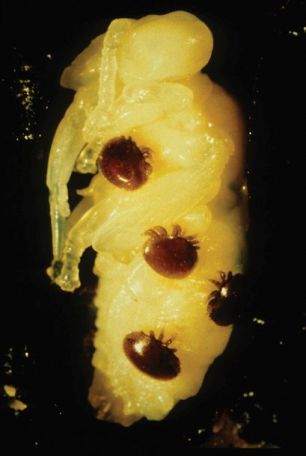
Varroa Mite
What is Varroa mite? 
Varroa mites (Varroa jacobsoni and V. destructor) are the most serious pest of honey bees worldwide. The mites are tiny reddish brown external parasites of honey bees.
How is it characterised?
On their own, individual mites are easily identifiable to the naked eye. Left untreated varroa mite will kill any bee hive it infects. All feral and untreated bee colonies will eventually die.
How is it spread?
Drone bees are able to move varroa mites from hive to hive and even between apiaries. Mites are agile, move into hives quickly and transfer through contact between bees. There are strict quarantine requirements in place to protect the Australian honey bee industry.
Where is it found?
Varroa infects honey bees in every major beekeeping area of the world, including Australia. It was detected in NSW in June 2022.
How is it detected?
Varroa can be detected by beekeepers using monitoring techniques such as alcohol washing, soapy water wash, sugar shake. All beekeepers in NSW are required to complete regular inspections for pests and diseases and report any Varroa detections in NSW.
Report your surveillance results here
How is it treated?
If a beekeeper finds a pest or disease in a hive they must take appropriate steps to manage its impact on the infected hive(s) and to prevent its spread to other hives. Varroa can be treated using chemical and non-chemical treatments. Beekeepers are encouraged to use an Integrated Pest Management approach to treatment. Refer to the Primefact below for more information on treating for Varroa.
Primefact Varroa mite management options in NSW
How do I report it?
Positive surveillance results must be reported by online form, calling 1800 084 881 or emailing biosecurity@dpi.nsw.gov.au
Are you an unregistered beekeeper?
You can register now here
Do varroa mites affect native bees?
No, varroa mites affect honey bees, they do not affect native bees.
More information about Varroa mite
For more information, see the varroa mite primefact.

